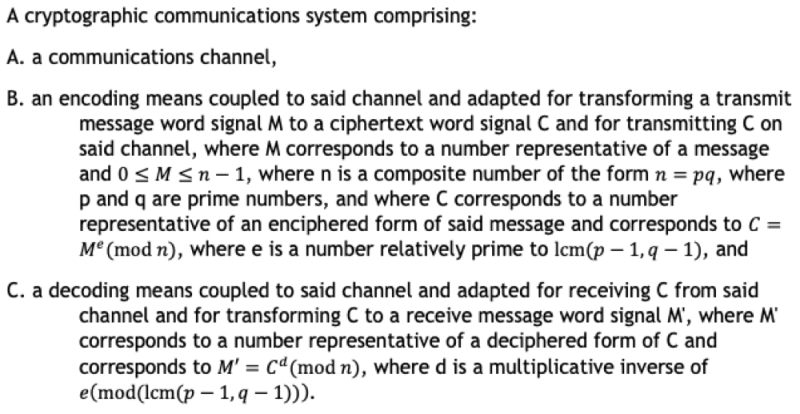Note: The below is a sarcastic parody, in the spirit of our earlier sarcastic parodies.
 WASHINGTON D.C., June 23, 1984. In a unanimous decision, the Federal Circuit has ruled U.S. Patent No. 4,405,829 invalid under 35 U.S.C. § 101, finding the claimed invention directed to an abstract idea. The '829 patent, assigned to the Massachusetts Institute of Technology (MIT), was the brainchild of three of its professors, Ronald Rivest, Adi Shamir, and Leonard Adleman. Lauded in academic circles as one of the first viable public-key cryptosystems and duly granted by the U.S. Patent and Trademark Office, the Court nonetheless found that the patent lacked an inventive concept necessary for patentability.
WASHINGTON D.C., June 23, 1984. In a unanimous decision, the Federal Circuit has ruled U.S. Patent No. 4,405,829 invalid under 35 U.S.C. § 101, finding the claimed invention directed to an abstract idea. The '829 patent, assigned to the Massachusetts Institute of Technology (MIT), was the brainchild of three of its professors, Ronald Rivest, Adi Shamir, and Leonard Adleman. Lauded in academic circles as one of the first viable public-key cryptosystems and duly granted by the U.S. Patent and Trademark Office, the Court nonetheless found that the patent lacked an inventive concept necessary for patentability.
Soon after issuance, MIT sought to license the patent to various companies developing security software and hardware. Speaking under condition of anonymity, in-house counsel at one of these companies said, "We knew that there was no way the courts would uphold this patent, so there was no reason to take it seriously." A number of these potential licensees joined a declaratory judgment action, asking the U.S. District Court for the District of Massachusetts to find the claims of the patent ineligible. The District Court did so, and MIT appealed to the Federal Circuit.
Claim 1, which was agreed to be representative, recites:

The Court began its analysis "by first determining whether the claims at issue are directed to a patent-ineligible concept, such as law of nature, natural phenomena, or abstract idea." This did not take long, as it noted that, "[t]he focus of the claims, as is plain from their terms, is on encoding a message into ciphertext using mathematical techniques and decoding the message from the ciphertext using complementary mathematical techniques -- that is all abstract."
MIT countered, arguing that the claimed invention was "revolutionary in nature." It asserted that, prior to the '829 patent, encryption was largely based on symmetric keys. Such systems involved using a key to encrypt a message to ciphertext, and the same key again to decrypt the ciphertext back into the message. The disadvantage of such a system is that the symmetric key had to first be shared or distributed across an insecure medium in order to be effective. The claimed invention, according to MIT, overcame this technical barrier by generating two mathematically inverse keys -- a public key (e), and a private key (based on d, p, and q). The security of the system relied on the intractability of factoring large prime numbers (p and q). Further, MIT contended that the claimed cryptosystem would facilitate "many future innovations, such as electronic commerce, virtual private networks, security of stored data, and military communications."
The Court was not convinced, stating that "even if the techniques claimed are groundbreaking, innovative, or brilliant, that is not enough for eligibility -- a claim for a new abstract idea is still an abstract idea." Notably, the Court found that "the subject matter is nothing but a series of mathematical calculations based on selected information." Moreover, the Court was skeptical about the potential of the claimed cryptosystem, relying on statements made by the challengers' expert indicating that "it would be dozens of years before computers were powerful enough to carry out the claimed exponentiations a reasonable time frame."
Finding the claim directed to an abstract idea, the Court moved on to determining whether the remaining elements of the claim constitute an inventive concept. Such a concept needs to be "sufficient to transform the claimed abstract idea into a patent eligible application." Here, the Court found that all additional elements, such as the encoding means, decoding means, and communications channel, "merely invoke well-understood, routine, conventional components and activity to apply the abstract idea identified previously." Indeed, the Court noted that the encoding means and decoding means were "functionality claimed at a high level of generality, thus failing to limit the claim to a particular embodiment of this abstract idea." Particularly, "nothing in the claims, understood in light of the specification, requires anything other than an off-the-shelf, conventional computer, or components thereof."
MIT attempted to establish that its technique was unconventional, but the Court rapidly shot down that notion. It held that "the mathematical principles that MIT refers to may indeed be innovative, but they are also abstract," and "one cannot argue that a concept held abstract under part one of the analysis is inventive under part two." Additionally, the Court observed that "the allegedly unconventional technique did no more than apply longstanding, well-understood mathematical operations -- multiplication, exponentiation, and modulus, for example."
Thus, the claims lack an inventive concept and fail the § 101 test. The Court summed up by stating, "[a]n inventor who makes an advance such as this one cannot obtain patent protection for the advance itself and must seek protection outside of patent law, such as in the law of trade secrets."